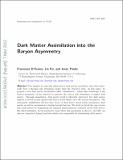| dc.contributor.author | D'Eramo, Francesco | |
| dc.contributor.author | Fei, Lin | |
| dc.contributor.author | Thaler, Jesse | |
| dc.date.accessioned | 2012-08-07T15:20:27Z | |
| dc.date.available | 2012-08-07T15:20:27Z | |
| dc.date.issued | 2012-03 | |
| dc.date.submitted | 2011-12 | |
| dc.identifier.issn | 1475-7508 | |
| dc.identifier.issn | 1475-7516 | |
| dc.identifier.uri | http://hdl.handle.net/1721.1/72013 | |
| dc.description.abstract | Pure singlets are typically disfavored as dark matter candidates, since they generically have a thermal relic abundance larger than the observed value. In this paper, we propose a new dark matter mechanism called "assimilation", which takes advantage of the baryon asymmetry of the universe to generate the correct relic abundance of singlet dark matter. Through assimilation, dark matter itself is efficiently destroyed, but dark matter number is stored in new quasi-stable heavy states which carry the baryon asymmetry. The subsequent annihilation and late-time decay of these heavy states yields (symmetric) dark matter as well as (asymmetric) standard model baryons. We study in detail the case of pure bino dark matter by augmenting the minimal supersymmetric standard model with vector-like chiral multiplets. In the parameter range where this mechanism is effective, the LHC can discover long-lived charged particles which were responsible for assimilating dark matter. | en_US |
| dc.description.sponsorship | United States. Dept. of Energy (cooperative research agreement DE-FG0205ER41360) | en_US |
| dc.description.sponsorship | United States. Dept. of Energy (Early Career research program DE-FG02- 11ER-41741) | en_US |
| dc.language.iso | en_US | |
| dc.publisher | IOP Publishing | en_US |
| dc.relation.isversionof | http://dx.doi.org/10.1088/1475-7516/2012/03/010 | en_US |
| dc.rights | Creative Commons Attribution-Noncommercial-Share Alike 3.0 | en_US |
| dc.rights.uri | http://creativecommons.org/licenses/by-nc-sa/3.0/ | en_US |
| dc.source | Prof. Thaler via Mat Willmott | en_US |
| dc.title | Dark matter assimilation into the baryon asymmetry | en_US |
| dc.type | Article | en_US |
| dc.identifier.citation | D’Eramo, Francesco, Lin Fei, and Jesse Thaler. “Dark matter assimilation into the baryon asymmetry.” Journal of Cosmology and Astroparticle Physics 2012.03 (2012): 010-010. | en_US |
| dc.contributor.department | Massachusetts Institute of Technology. Center for Theoretical Physics | en_US |
| dc.contributor.department | Massachusetts Institute of Technology. Department of Electrical Engineering and Computer Science | en_US |
| dc.contributor.department | Massachusetts Institute of Technology. Department of Physics | en_US |
| dc.contributor.approver | Thaler, Jesse | |
| dc.contributor.mitauthor | D'Eramo, Francesco | |
| dc.contributor.mitauthor | Fei, Lin | |
| dc.contributor.mitauthor | Thaler, Jesse | |
| dc.relation.journal | Journal of Cosmology and Astroparticle Physics | en_US |
| dc.eprint.version | Author's final manuscript | en_US |
| dc.type.uri | http://purl.org/eprint/type/JournalArticle | en_US |
| eprint.status | http://purl.org/eprint/status/PeerReviewed | en_US |
| dspace.orderedauthors | D'Eramo, Francesco; Fei, Lin; Thaler, Jesse | en |
| dc.identifier.orcid | https://orcid.org/0000-0002-2406-8160 | |
| mit.license | OPEN_ACCESS_POLICY | en_US |
| mit.metadata.status | Complete | |
